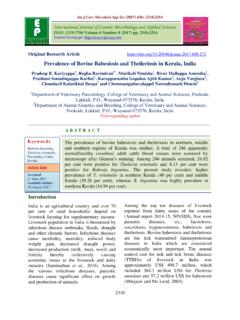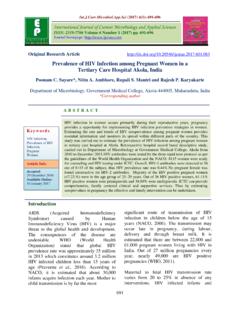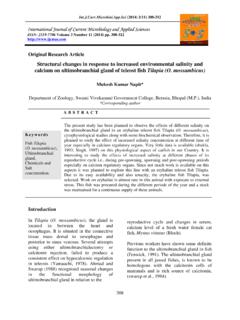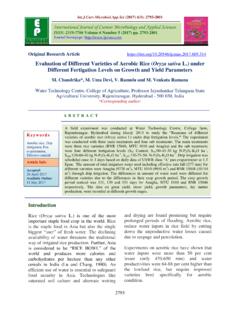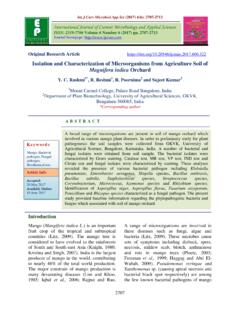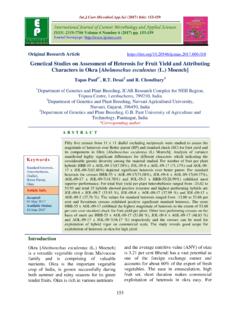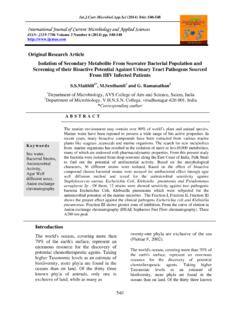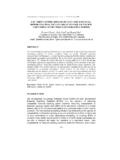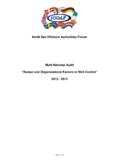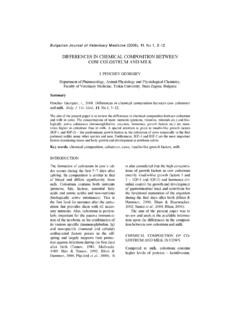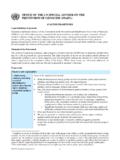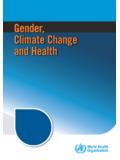Transcription of Factors Affecting Post-Harvest Life of Flower Crops
1 (2018) 7(1): 548-557 548 Review Article Factors Affecting Post-Harvest life of Flower Crops Jagreeti Gupta* and Dubey Department of Floriculture and Landscaping, Punjab Agricultural University, Ludhiana, Punjab, India *Corresponding author A B S T R A C T Introduction Flowers have always remained an integral part of human s life and they are very important in the Indian traditional way of life . With increasing standard of living the demand for flowers has increased and meeting these demands depends largely on increasing the production and more importantly proper Post-Harvest handling at all levels. In floriculture industries the Post-Harvest losses is a major issue and is a worldwide problem. India has exported 22, MT of floriculture products to the world for the worth of crores in 2013-14 (Anonymous, 2014).
2 On the other hand because of their highly perishable nature, flowers are vulnerable to large Post-Harvest losses. Delayed Flower senescence and good presentability are essential for the marketable flowers and are also important goal of researchers. Longer Post-Harvest life of flowers makes sure that the customers, retailers and final consumers will be satisfied and will return back to purchase more flowers. For increasing the Post-Harvest life of flowers, we should know about the Factors that affect Post-Harvest life , so that we can provide required condition to plant and hence, Post-Harvest life will be increased. This review provides an overview about the Factors Affecting Post-Harvest life of Flower Crops and ways to increase their life and hence profitability.
3 International Journal of Current Microbiology and Applied Sciences ISSN: 2319-7706 Volume 7 Number 01 (2018) Journal homepage: Prolonging the Post-Harvest life is essential to assure more life of flowers. For prolonging vase life , we should study about the pre- harvest , harvest and post - harvest Factors of Flower Crops that ultimately affects the Flower life . There are a series of steps involved to prepare flowers for market after harvesting known as Post-Harvest handling. These steps include: Harvesting, Conditioning, Pre-cooling, Pulsing, Grading, Bunching, Wrapping, Packaging, Storage, Transport and Sale. All the Factors that affect Post-Harvest life of a Flower should managed properly to provide optimum condition for plant growth. Different biocide, holding, pulsing solution, growth regulators and different storage temperature are used to promote vase life of lowers.
4 K e y w o r d s Senescence, Vase life , Shelf life , Pulsing solution, Holding solution Accepted: 06 December 2017 Available Online: 10 January 2018 Article Info (2018) 7(1): 548-557 549 Need for proper Post-Harvest handling practices Flowers remain alive even after harvest and continue their metabolic activities causing depletion of carbohydrates, rise in temperature and respiration rates, rapid attack by micro-organisms, water stress and increased accumulation of ethylene. All these activities lead to deterioration of the harvested flowers which in turn decreases the longevity of the fresh produce. There arises the need for the appropriate Post-Harvest handling technologies (Nowak and Rudnicki, 1990). The major Factors which lead to the deterioration of the harvested flowers can be classified as: 1) Pre- harvest Factors , 2) harvest Factors and 3) Post-Harvest Factors (Salunkhe et al.
5 , 1990 and Bhattacharjee and De, 2003) Pre- harvest Factors Affecting Flower longevity Genetic or inherent makeup Post-Harvest longevity of Flower species and cultivars vary considerably due to differences in their genetic make-up. Anthurium and orchids have longer vase life than rose and Dianthus, whereas lilies have shorter vase life than rose and gerbera (Bhattacharjee and De, 2003). Baccara roses have longer vase life and possesses ability to close their stomata upon cutting than golden wave roses, which possesses short vase life (Mayak et al., 1974) Environmental Factors Light Light regulate several physiological processes such as photosynthesis, which determine the carbohydrate content of flowers. Flowers containing relatively higher amounts of carbohydrates especially sugars, last longer in the vase.
6 High light intensity causing Scorching of the foliage and Flower buds, dropping of leaves and petal senescence where as Low light causes Blueing/ discolouration of petal and Bent Neck in Rose and Stem Bending in Gerbera (Halevy and Mayak, 1979). Temperature Temperature requirement of different Crops vary. For example: In rose, the day temp. 20-25 C and night temp 16 C, is required. A difference of 10 C day and night temperature is considered ideal for growth and Flower production. Low night temperature are advantageous because of low respiration rates at low temperature decreases the utilization of sugars, thereby improving the net accumulation of carbohydrate in the petals. High temperature accelerates the respiration rate and hence, reduces net carbohydrate reserves leading to poor Post-Harvest life .
7 Too low temperature also causes freezing injury to buds (Halevy and Mayak, 1979). Humidity Optimum level of humidity is required by different Crops . For example rose require relative humidity between 60-65 %. High humidity leads to fungal and bacterial diseases whereas, Low humidity leads to browning of leaf edges, thin leaves. At higher air humidity (90%) and a 24 h photoperiod reduces the Post-Harvest life of several cultivars of Rose. The reduction was attributed to the increased rate of water loss from the leaves due to the failure of stomata to close (Mortenseon and Fjeld, 1998) Season Variation in the longevity of cut flowers due to the seasonal effects has also been reported. Chrysanthemum harvested during hot seasons (2018) 7(1): 548-557 550 shown longer vase life than those during cold season.
8 High light intensity associated with higher photosynthetic activity for increased longevity of cut flowers (Singh et al., 2013). Sugar content of petals increases in autumn and decreases slightly towards summer, while chlorophyll intensity increases gradually towards spring and decrease in summer (Celikel and Karacaly, 1995). Ethylene The longevity and quality of cut flowers also depend upon the composition of ambient atmosphere. Ethylene caused the most adverse effects on cut flowers. In carnation, ethylene first produced in gynoecium. Carbon dioxide The atmospheric content of CO2 is very less % (Kumar et al., 2002). It is essential for photosynthesis. CO2 enrichment in greenhouse is advantageous as it improves quality and increases yield and vase life . Pests Flower Crops are attacked by various pests and affect the quality of flowers.
9 Stage of maturity Decrease in trend of total and reducing sugar is observed in leaves, whereas increase trend is observed in the total and reducing sugar of corolla from harvest towards senescence. harvest Factors Affecting Flower longevity The right stage, method and time of harvesting of flowers are of considerable importance to ensure their long vase- life . Time Flowers should always be harvested either in morning or evening when temperature is moderate because high temperature leads to faster respiration and excessive water loss. Method of harvesting The stems should be cut with sharp knives or secateurs. Hardwood stems should always be given slanting cut to expose maximum surface area to ensure rapid water absorption. The flowers of dahlia and poinsettia release latex upon cutting.
10 To overcome such problem, stems should be given a dip in hot water (80-900C) for a few seconds. Stage of harvesting Flowers should always be harvested at an optimum stage of maturity. Too immature buds do not open whereas over mature ones wither quickly. Post-Harvest Factors Affecting vase life Temperature Opening of Flower buds and rate of senescence accelerate at higher temperature. At low temperature, respiration comes down, Flower produces less amount of ethylene and multiplication if micro-organism does not takes place at faster rate. The most important metabolic process is respiration that increases with increase in temperature. Humidity Cut flowers should be kept at 90-92 % relative humidity for maintaining turgidity beneficial for prolonging the vase life of cut Flower during Post-Harvest (Doi et al.)

